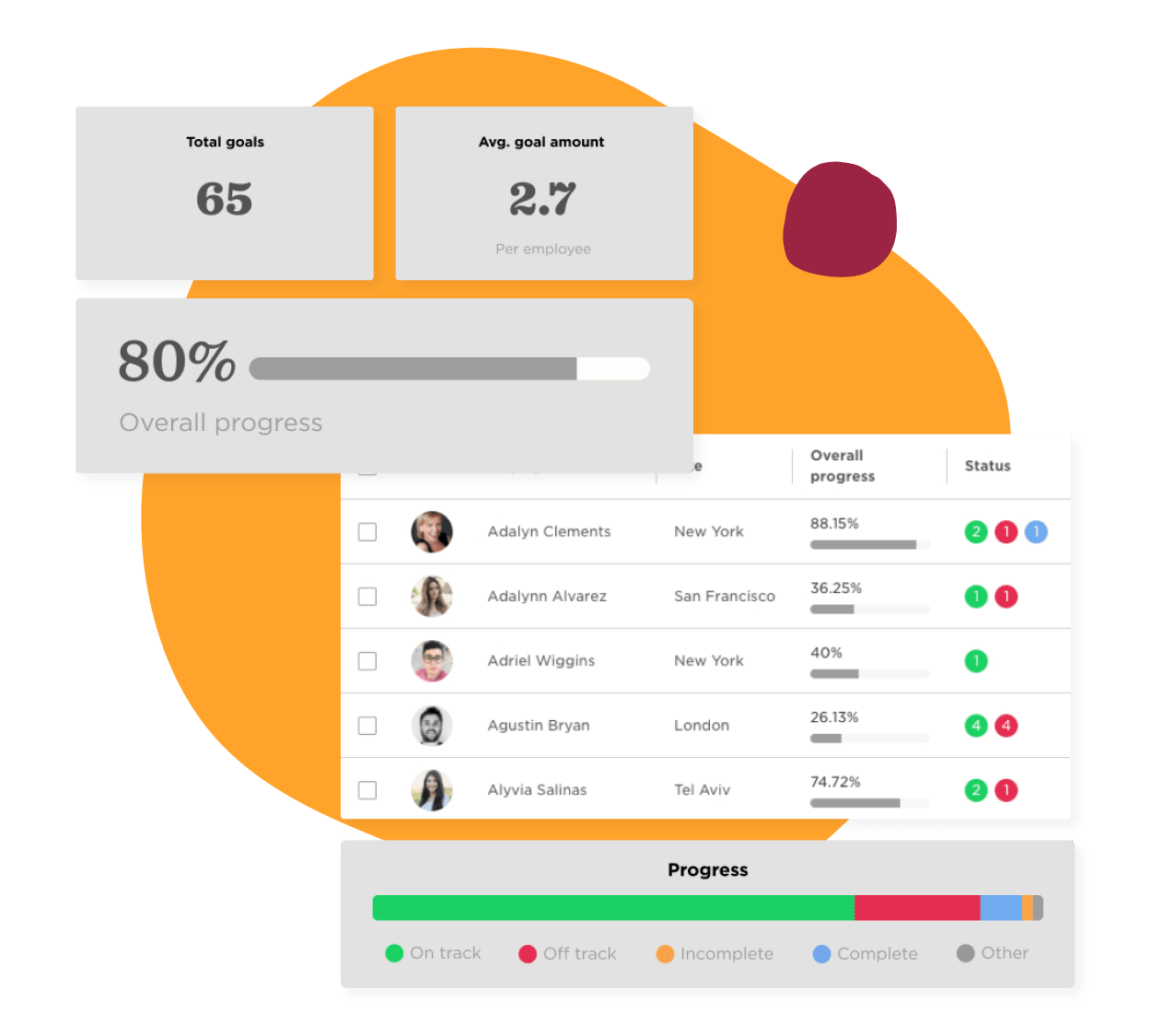The concept of setting goals isn’t new. The idea of goals has been around since before the common era when the Greek philosopher Aristotle identified that “purpose causes action.” Cecil Alec Mace conducted the first studies on goal-setting in 1935.
In the 1960s, psychologist Edwin Locke (aka the “goal-setting pioneer”) expanded on Aristotle’s thought to establish his theory about goals. Locke determined that individuals who set clear, challenging goals performed better than people who set wide-ranging, simple goals.
Of course, the benefits of goal setting remain true today–especially when it comes to engaging your workforce. Companies that set performance goals quarterly can generate 31% more returns than those reassessing annually, according to HR researcher and expert Josh Bersin.

Goals and employee engagement
Goals are a proven method for engaging and motivating employees. When goals are achievable, they boost employee confidence, lead to small wins, and contribute to positive organizational outcomes.
It’s easy to understand why goals are so effective. They provide a plan of action and establish a clear endpoint, which provides valuable structure and purpose to employees’ work. More importantly, goals are an essential key to employee engagement.
An employee engagement strategy includes many different elements, including compensation and professional development. Two of the most critical components required for engagement are goal setting and recognition, according to the Society for Human Resource Management (SHRM). Without these two elements, SHRM believes your organization “won’t be able to move full speed ahead toward engagement.”

How can HR help organizations, managers, and employees achieve goals?
While philosophers, psychologists, and business leaders may all agree that goals drive performance, there’s often a gap between setting goals and achieving them. In organizations, the root of unachieved goals is often due to a lack of clarity.
The Leadership Workplace Accountability Study surveyed over 40,000 participants and found that:
- 93% of respondents believed a “lack of clarity hinders them from aligning their work or taking accountability for desired results.”
- 70% of respondents said that the lack of clarity puts their organization’s key results in jeopardy.
Without an overall plan regarding selecting, tracking, and reaching goals, it’s hard–if not impossible–to make progress. HR plays a crucial role in providing people with the information they need to succeed in achieving goals.
A variety of factors impact the likelihood that an organization and its employees will achieve its goals. HR can address those factors, including providing access to the organizational strategy; emphasizing the elements of effective goals; and reinforcing how to set realistic goals.
By working with leaders, managers, and employees to help develop goals, HR demonstrates that the organization invests in organizational and individual success. This demonstrated commitment provides inspiration and a sense of engagement that helps employees keep striving for success, even during challenging times.
Provide access to the organizational strategy
Employees and managers should have access to their company’s strategic plan. Organizations often struggle to bridge the gap between strategy and day-to-day implementation, but employees have the visibility they need with access to the plan.
“Employees will be more effective if they can see how their individual goals fit into the big picture,” according to McKinsey. “In recent years, there has been an uptick in the number of companies linking organizational business goals to functional business objectives and converting those into team-performance goals. This encourages accountability, and better performance as individuals grasp the direct impact of their performance.”
Having access to the strategy helps create a sense of purpose for all employees. The legend of John F. Kennedy’s visit to the NASA space center provides the perfect illustration. As the story goes, when Kennedy asked a janitor what he was doing, the janitor replied, “I’m helping put a man on the moon.”
How HR can help
By sharing documents, facilitating informational discussions, or embedding the strategy within performance management systems, HR can provide all employees with access to the organizational strategy. This clarifies the “big picture” and assists managers and employees in understanding where the organization’s desired path.

Emphasize the elements of effective goals
It may be easy for people to pick a goal they want to achieve. But everyone needs to craft goals in a way that ensures they are a balance of being practical and obtainable, as well as challenging and inspiring.
Especially in a work setting, goals should be:
- Clear and easy to communicate: There’s no need for flowery language or complex metrics. Make goals as simple and easy to understand as possible. This helps keep them top of mind and empowers employees to do the work.
- Challenging yet achievable: Goals shouldn’t be impossible to achieve, but to be effective, they should inspire someone to act.
- Intentional, as well as inspiring: It’s vital that you have intention behind a goal and that you’re not making goals for the sake of filling out a form. While you want them to be realistic, it’s also important to leave room for inspiration. Often inspirational goals pave the road for amazing innovation.
- Measurable: Vague goals lead to vague–or non-existent–results. To ensure goals are met, establish a metric by which they can be measured. Tangible, trackable evidence makes it easy to identify if you’re making progress against the goal or not.
As Michelangelo said, “The greater danger for most of us isn’t that our aim is too high and we miss it, but that it is too low, and we reach it.”
When employees craft and measure clear, challenging, and intentional goals, those goals inspire commitment, enabling the employee to achieve desired results.
How HR can help
Setting effective goals is a learned skill–for managers and employees alike. As an HR department, you can lead the way to ensure goals are compelling. First, make sure all HR team members understand how to craft effective goals. This will ensure they know how to offer feedback and suggestions when reviewing goals. Then consider offering training sessions about preparing goals and be sure it covers the elements of effective goals. Finally, incorporate goal tracking within your HRIS to ensure everyone can measure their progress.
Set and reinforce goals to empower employees
According to McKinsey’s research, goal-setting can help improve employee engagement to benefit organizations and engage employees when done well.
But reinforcing takes almost as much effort as meeting them. Use these six strategies to help your organization effectively set, reinforce, and achieve goals:
- Connect team goals to company goals. Setting goals shouldn’t be a top-down process. HR and business leaders need to collaborate with managers to establish goals that help ensure departmental objectives and team projects have strong ties to organizational goals.
- Tie individual goals to team and company goals. When employees understand how their work contributes to organizational growth, it serves to motivate them. To keep employees engaged, your HR team should frequently emphasize and communicate organizational goals. As managers set goals with their team members, each goal should be tied to at least one of the company’s strategic objectives.
- Set deadlines. To increase motivation and boost morale, it’s essential to give employees a deadline. Without a deadline, goals lack structure and purpose. At the same time, it’s important to strike a balance between a sense of urgency and unrealistic timelines that are impossible for employees to achieve.
- Track and measure progress. Find a benchmark you can use to measure progress towards a goal. A measurable goal is one that’s connected to a metric. Clarity about goal measurement helps everyone identify when a target has been met. A study about goal setting found that business participants who sent weekly reports about their goals accomplished more than those who didn’t write their goals down.
- Connect goals to professional development. The most powerful goals are those that not only benefit the organization but also support the individual’s career and professional growth. As employees set and reach their goals, connect what they’ve achieved to their professional development. Identify how the goals have helped them learn new skills and find ways to link new goals to their career growth.
- Recognize wins. When the company, team, or individual accomplishes a goal, it’s time to celebrate! Recognizing the achievement of the goals you’ve set demonstrates to all employees that the organization values and appreciates the effort. This serves to incentivize and inspire everyone to continue developing the goals that will move the organization forward.
How HR can help
A strong performance management strategy is tied to every aspect of goal setting. Whether it’s how you measure goals, connect them to professional development, or reward employees for their achievements, HR must embed goals within the company’s approach to managing performance. When it comes to people priorities in your organization, ensure you embed these strategies are part of the systems and processes you use to manage performance.

Scenario
Let’s see how these six strategies can help a company’s customer service goal to reduce customer complaints by 50% by the end of the fiscal year. The plan for achieving this goal is to guarantee that customers receive a response within 24 hours of contacting the company.
- Connect team goals to company goals. Based on the company customer service goal and response time requirement, the IT department creates a team goal to improve notification management within the customer relationship management (CRM) system capabilities.
- Tie individual goals to team and company goals. The IT lead responsible for the CRM vendor relationship sets a goal to work with the vendor to identify system updates the company can implement to ensure employees receive timely notifications about customer communications.
- Set deadlines. Based on the company goal deadline of the end of the fiscal year, the IT lead sets a deadline to have the system updates in place within four to six months.
- Measure progress. The IT manager adds this goal to the employee’s performance tab within the HRIS. The manager also sets up a reminder in the system to check in about goal progress every other week.
- Connect goals to professional development. Due to the high impact this goal has on the organization, the manager also sees an opportunity to increase the IT lead’s comfort level speaking to leaders. The manager invites the employee to sign up for a presentation skills workshop to ensure they are confident about presenting the solution and results to executives.
- Recognize wins. The IT manager celebrates each step the employee takes towards achieving the goal. The recognition includes everything from a simple “thank you for your efforts” email to sharing positive feedback during team meetings and eventually presenting a formal award at the year-end.
Regardless of the industry or role, it’s clear that accountability, commitment, and actively tracking goals all positively influence an individual’s commitment and ability to reach a goal. As Aristotle found, a sense of purpose is what will drive action. As HR leaders and professionals, if we want to enjoy the benefits of an engaged workforce, it’s our responsibility to ensure that a sense of purpose is behind the goals our organization sets.

Recommended For Further Reading
Conclusion
Not sure if your employees are inspired by organizational goals? Ask yourself this question: If John F. Kennedy asked them what they were doing, how would they respond?
Ensuring that every member of the organization is empowered to set and reach goals is a critical part of HR’s role. Employees want to see how their efforts and work products contribute to company objectives, and managers want to measure their team’s performance against goals.
Setting the right goals and tracking progress makes the connection between the organization and each employee clear. As an HR professional, do what you can to inspire positive goal practices in your organization. Start by establishing and monitoring goals, leaders have real-time updates about progress, managers are able to provide timely feedback, and employees have the information they need to motivate their best performance.
Meet Bob

Goals in Bob are designed to allow you to clearly map out and measure your own and others’ goals. Divided into company goals, department goals, and individual goals, you can ensure your people are aligned and clear on their own goals and the larger goals of the organization. No matter what method you use to set goals (OKRs, SMART, and more), you can clearly map and measure with ease.
